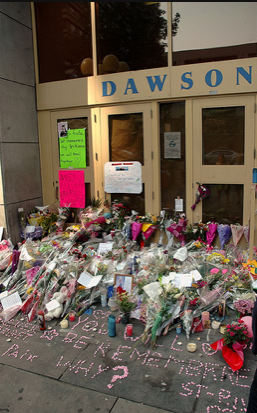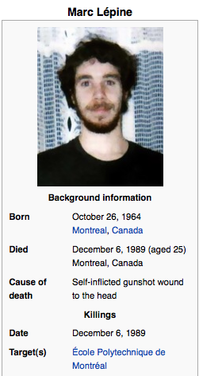Blood Trails at School
Andréane Monty
 Montreal's history is shadowed by devastating
tragedies. Indeed, the massacres that took place in the École Polytechnique and
at the Dawson College touched a whole continent.
Montreal's history is shadowed by devastating
tragedies. Indeed, the massacres that took place in the École Polytechnique and
at the Dawson College touched a whole continent.
These heartbreaking shootings,
which targeted innocent students with a whole life ahead, ravaged a whole
people. Even though they occurred seventeen years apart and are unrelated
cases, some similarities are noticeable between the two shootings. In fact, a
serious comparison of the two massacres shows that they are more alike than we
would think.
 December 6th of 1989 a young man entered the École
Polytechnique unnoticed, with a hunting knife and a gun. Marc Lépine, son of an
Algerian immigrant and a woman from Québec, went to an engineering class and
asked the fifty men to leave and asked the nine women that were left if they
knew why he was there. When they answered no, he said: "I am fighting
feminism." One of the students, Nathalie Provost, tried to reason with the
angry shooter: "Look, we are just women
studying engineering, not necessarily feminists ready to march on the streets
to shout we are against men, just students intent on leading a normal life."
Lépine then answered: "You're women; you're
going to be engineers. You're all a bunch of feminists. I hate feminists"
before opening fire from left to right, killing six of the nine women, wounding
three. He then continued to the second floor and killed a woman through the
window of the door she had just locked.
December 6th of 1989 a young man entered the École
Polytechnique unnoticed, with a hunting knife and a gun. Marc Lépine, son of an
Algerian immigrant and a woman from Québec, went to an engineering class and
asked the fifty men to leave and asked the nine women that were left if they
knew why he was there. When they answered no, he said: "I am fighting
feminism." One of the students, Nathalie Provost, tried to reason with the
angry shooter: "Look, we are just women
studying engineering, not necessarily feminists ready to march on the streets
to shout we are against men, just students intent on leading a normal life."
Lépine then answered: "You're women; you're
going to be engineers. You're all a bunch of feminists. I hate feminists"
before opening fire from left to right, killing six of the nine women, wounding
three. He then continued to the second floor and killed a woman through the
window of the door she had just locked.
He made his way to the first floor
cafeteria where he killed three women and stabbed a woman thrice with his
hunting knife, killing her, in a third floor classroom, before exclaiming: "Oh
shit!" and committing suicide. At the end of this tragic day, fourteen women
who had a promising future ahead were uselessly slaughtered by a man who
society failed to help. December 6th is now known as the National Day of
Remembrance and Action on Violence Against Women.
 September 13th 2006, 12h30, seventeen years
later, a dark young man wearing a long, black overcoat and a Mohawk hairstyle
arrived at the Dawson College by the Maisonneuve entrance. Kimveer
September 13th 2006, 12h30, seventeen years
later, a dark young man wearing a long, black overcoat and a Mohawk hairstyle
arrived at the Dawson College by the Maisonneuve entrance. Kimveer
Gill carried
four weapons and additional munitions.
12h41, he shot the first bullets at
students on the steps of Dawson College before making his way into the
building, straight to the cafeteria, where most of the students were eating,
unaware of the tragedy that was about to take place.
12h42, Gill moved to a
corner of the room and fired a shot to the floor before aiming at students in
front of him. He told everyone to lie down on the floor and shot other students
until he was met head-on by two police officers who were visiting the school at
that time regarding an unrelated event. Additional police officers surrounded
the campus, very quickly compared to the shooting of 1989. Confronted to the
two law enforcement agents, Gill took two hostages.
12h48, he was shot to the
arm by Officer Denis Côté and committed suicide by gunshot wound to the head.
Luckily, the police arrived much faster than in 1989, and the shooting ended
only twenty minutes after it had begun. But it was enough for Gill to kill
Anastasia de Sousa, and injure nineteen other students.
The shooter's parents were from Punjabi, a region of Pakistan where the religious beliefs and traditions are very strong and very misogynous. Gill was an angry man, his anger towards society was so great that he felt there was no hope and killed himself, but made sure to leave a bloody mark onto Montreal's history and murdered a young girl who no longer has a future.
Twice in Montreal's history did young women lose their lives because men needed help but did not find it. Both shooters, sons of immigrants, had strong beliefs and felt women were inferior to men and while Lépine directed his anger towards women, Gill hated the whole society. Both felt powerless and believed that the only way for them to change the world was by killing. Gill and Lépine both left suicide letters that were profoundly shocking for everyone; Lépine clearly stated that feminists were the reason to his failure in life, while Gill deplored the fact that gothics were more often the target to bullying and prejudice. Lépine's motives were purely political while Gill's were more personal since they regarded his own experience of bullying at school.
The shootings of the Dawson College and at the École Polytechnique profoundly touched the whole North American society, and many journalists and specialists began asking themselves: "Is something wrong with our society?" Indeed, an American journalist, Jan Wong columnist from the Globe and Mail stated that Marc Lépine and Kimveer Gill had been alienated from Quebec society and that was the reason to their desperate acts. Of course, this hypothesis was put aside but it is a question that is very important to ask: "Who should be blamed, the shooters or the society in which they could not be accepted?" In memory of the victims, it is now time we found an answer to these questions and prevented another massacre to occur in our schools, where the keys of our future, the students, are still learning.
Journal entries from Kimveer Gill
Leave a comment